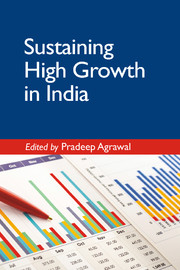Book contents
- Frontmatter
- Contents
- List of Tables
- List of Graphs and Maps
- Preface
- Introduction
- Section 1 Ensuring Macroeconomic Stability for Sustaining High Growth Rates
- Section 2 Promoting Industrial Development for Sustaining High Growth Rates
- Section 3 The International Economic Issues and Sustaining High Growth
- Section 4 Infrastructure Bottlenecks to Sustaining High Growth
- 10 Infrastructure, Human Capital and Economic Growth: A Quantitative Analysis for India
- 11 Elementary Education in India: A Study of Accessibility and Quality
- 12 Education and Economic Growth: A Comparative Study of China and India
- Section 5 Some Socio-political Issues in Sustaining High Growth
- List of Contributors
- Obituary
- Index
12 - Education and Economic Growth: A Comparative Study of China and India
from Section 4 - Infrastructure Bottlenecks to Sustaining High Growth
Published online by Cambridge University Press: 08 February 2018
- Frontmatter
- Contents
- List of Tables
- List of Graphs and Maps
- Preface
- Introduction
- Section 1 Ensuring Macroeconomic Stability for Sustaining High Growth Rates
- Section 2 Promoting Industrial Development for Sustaining High Growth Rates
- Section 3 The International Economic Issues and Sustaining High Growth
- Section 4 Infrastructure Bottlenecks to Sustaining High Growth
- 10 Infrastructure, Human Capital and Economic Growth: A Quantitative Analysis for India
- 11 Elementary Education in India: A Study of Accessibility and Quality
- 12 Education and Economic Growth: A Comparative Study of China and India
- Section 5 Some Socio-political Issues in Sustaining High Growth
- List of Contributors
- Obituary
- Index
Summary
Introduction
The initial conditions in 1950 of the newly formed People's Republic of China (PRC) and newly independent India – the world's two most populous economies – were similar: low per capita income, high levels of poverty and low education. However, they followed dramatically different political systems – a highly centralized one party system with first a command and then a socialist market economic structure in China and a multi-party democratic parliamentary political system with a highly regulated capitalist economic structure in India. China has attained a miracle by sustaining high growth rates and attaining the top rank in an international student assessment test. China sustained high growth rates, close to 10 percent, over the past 35 years. In recent years, Shanghai-China ranked top among the 74 countries of the OECD and 10 other countries in the PISA tests in science, mathematics, and reading for 15-year-old schoolchildren. India has not done as well. Except for a brief spurt of high growth in the 1990s and early 2000s, India's growth rates have been around 5 per cent during the period. In the PISA tests in 2009, India ranked next to last, just above Kyrgyzstan and in the Trends in International Mathematics and Science Study (TIMSS) test among 51 countries in 2005, India ranked near the bottom (Pritchett (2012) for PISA results and Das and Zajonc (2010) for TIMSS results). No country in the world achieved Newly Industrialized Country (NIC) status without providing its labour force a high-quality education or at least providing basic education first and later vocational secondary education and a high-quality tertiary education, at an internationally comparable standard. With high income growth over the past three decades, China reduced poverty by around 500 million people (World Bank, 2013). Like China, India would like to achieve persistent high economic growth and eliminate poverty.
What leads to sustained high economic growth? It has been argued in the literature that important sources of growth are globalization – along the lines of free international trade and capital movement – and policies that foster infrastructure, market competition, R&D and human capital.
- Type
- Chapter
- Information
- Sustaining High Growth in India , pp. 349 - 388Publisher: Cambridge University PressPrint publication year: 2017

